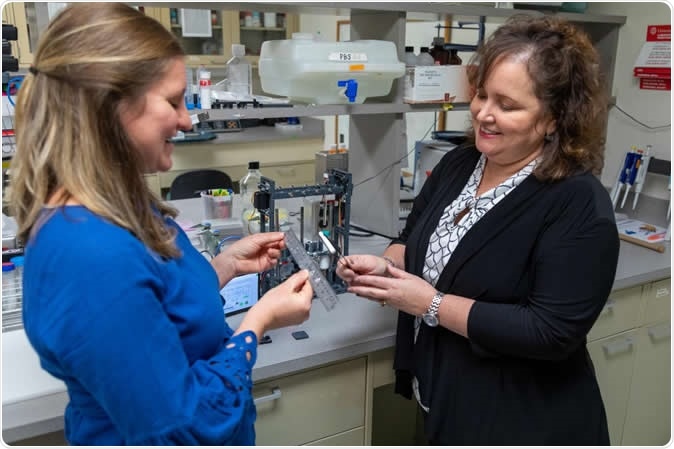Researchers have successfully tried a biodegradable bridge like device (biodegradable polycaprolactone PCL conduit) in vivo for management of nerve injuries. The team published their findings in a paper titled, “Long-gap peripheral nerve repair through sustained release of a neurotrophic factor in nonhuman primates,” in the latest issue of the journal Science Translational Medicine.

Lauren Kokai, Ph.D., (left) developed the technology used for this project when she was a graduate studying under Kacey Marra, Ph.D., (right). Credit: UPMC
Nerves form the working units of the central nervous system and those that extend from the brain and spinal cord are called part of the peripheral nervous system that lies in the limbs and other parts of the body. These carry signals to and from the brain. The team explained that there are annually over 600,000 nerve injuries in the United States and while some may repair and recover, thousands are left with debilitating paralysis or disabilities. Many of the injuries sustained by American soldiers are these nerve injuries explain the researchers. Similarly machinery accidents, car crashes and other automobile accidents, cancer treatment and diabetes also contribute to nerve damages.
They explained that when these nerves of the peripheral nervous system are damaged or nicked, they can heal on their own if the damage is not great. The gap between the cut ends needs to be short – around one third of an inch, in order to allow the nerve endings to connect and join. If the gap is greater, the chances of the nerve repairing itself become smaller, the team explains. Sometimes when the gap is greater, the nerve endings tend to start to grow and get tangled into knots without finding the other cut end. This leads to a ball like knot of nerve endings called a neuroma. Neuromas can be painful and nerve injuries often lead to neuromas that are chronically painful.
For patients who have had a severed nerve with a wide gap that prevents it from reconnecting and healing, surgeons and neurologists usually attempt to remove a healthy bit of a nerve from elsewhere (usually from the side or back of the leg) and place it over the gap. This is called an autograft. In many patients these autografts are capable of restoring more than 50 percent of the nerve activity. However, lead author of this study, Kacey Marra from the University of Pittsburgh, explains that this autograft could damage another area of the body from where the healthy nerve bit is taken. This region on the back of leg for example, from where the nerve part of taken, could become numb after the autograft. She said, “It's like you're replacing a piece of linguini with a bundle of angel hair pasta...It just doesn't work as well.”
Marra is also a professor of plastic surgery at Pitt and core faculty at the McGowan Institute for Regenerative Medicine. She said, “We're the first to show a nerve guide without any cells was able to bridge a large, 2-inch gap between the nerve stump and its target muscle. Our guide was comparable to, and in some ways better than, a nerve graft.”
Thus for this new study the team developed a new biodegradable bridge like device that has shown success in repairing nerve injuries in primates. This bridge is essentially a miniscule tube made up of a polymer that is used to make sutures that dissolve within the body by themselves. These biodegradable polymers are used widely for suturing and have been found to be safe. They usually dissolve by the time the stitch line has healed. In this biodegradable bridge created for nerve healing the researchers embedded microspheres of a glial cell derived neurotrophic factor. This protein embedded in the tube wall is a specific one that promotes neuronal survival.
Next the team implanted these tube-like devices into macaques with nerve defects in their arms. The tubes worked as scaffolds that helped the cut ends of the nerves to grow over them. After the end of the study the team noted that nearly 80 percent of the nerve function was restored by the time the tubes dissolved. Gaps as much as 12 centimetres or 4.7 inches also showed healing, wrote the researchers.
As a next step the team is working on planning human clinical trials with these tubes. The trials are set to begin in 2021 wherein the persons with nerve damage could benefit from these bridges that help the damaged ends of nerves to grow back and reconnect. Researchers are working on a startup company called AxoMax Technologies Inc. that would be working on the trials. Researchers explain that for humans it may take at least three years for the nerves to grow back, but if proven successful, these bridges could replace autografts as a method for repairing nerve damage.
Journal reference:
Long-gap peripheral nerve repair through sustained release of a neurotrophic factor in nonhuman primates, Neil B. Fadia, Jacqueline M. Bliley, Gabriella A. DiBernardo, Donald J. Crammond, Benjamin K. Schilling, Wesley N. Sivak, Alexander M. Spiess, Kia M. Washington, Matthias Waldner, Han-Tsung Liao, Isaac B. James, Danielle M. Minteer, Casey Tompkins-Rhoades, Adam R. Cottrill, Deok-Yeol Kim, Riccardo Schweizer, Debra A. Bourne, George E. Panagis, M. Asher Schusterman II, Francesco M. Egro, Insiyah K. Campwala, Tyler Simpson, Douglas J. Weber, Trent Gause II, Jack E. Brooker, Tvisha Josyula, Astrid A. Guevara, Alexander J. Repko, Christopher M. Mahoney and Kacey G. Marra, Science Translational Medicine, Vol. 12, Issue 527, eaav7753, DOI: 10.1126/scitranslmed.aav7753